Abstract
The micromechanical behavior of an Al/Al2Cu/Cu multilayer with characteristic crystal orientation during uniaxial tensile deformation was investigated by molecular dynamics. The simulation results showed that under tensile loading, the dislocation nucleates at the Cu/Al2Cu heterogeneous interface and moves toward the Cu layer along the {111} crystal plane. The deformation mechanism is intralayer confinement slip. As the dislocations proliferated, interactions between them occurred; resulting in the formation of insertion stacking faults and deformation twins in the Cu and Al layers. However, no dislocation lines were generated in the Al2Cu layer during tensile deformation. As the load increased, the stress concentration at the Al2Cu/Al interface led to the fracture of the complex. In addition, the microplastic deformation mechanism and mechanical properties of Al/Al2Cu/Cu composites at different temperatures and strain rates were significantly different. These results revealed the microdeformation mechanism of laminated composites containing brittle phases.
1 Introduction
A Cu/Al composite board [1–4] combines the low resistance and high thermal conductivity of copper with the lightweight and low price of aluminum to balance the price/performance combination of copper and aluminum. Its weight can be reduced by 35–50%, and its thermal and electrical conductivity is comparable to some copper alloys. Electrical power, heat, electronics, communications, new energy photovoltaics, and transportation all benefit from this combination. Using aluminum instead of copper reduces the amount of copper used, which contributes to the more efficient use of resources [5,6].
As a composite material with a multi-scaled configuration, the Cu/Al layered composite material has mechanical and physical properties closely related to the interface structure and preparation process [7–9]. There are differences in the initial state of the component layer raw materials used in different preparation methods, resulting in differences in the interface structure and microstructure of the composite board component layer obtained by different preparation methods, and the component layer microstructure evolves differently during annealing, resulting in large differences in the strength and plasticity of annealed composites with different preparation methods. Kim and Hong [7] studied the tensile deformation of Cu/Al/Cu layered composites. This study found that the composites’ tensile strength exceeded that of the law of mixing while examining the interaction between interactive deformation and composite toughness. Due to the constraints of the strong bonding interface, the interactive deformation of the copper layer and the aluminum layer beneficially improved the ductility of the Cu/Al composite. Liu et al. [8,9] prepared layered Cu/Al composites by casting-rolling. They found that in the cast-rolled state, the copper–aluminum composite plate produced a tougher composite. Through analysis of the microstructure evolution and the interface fracture behavior during the deformation of the tensile specimen, they initially believed that toughening in the Cu/Al composite plate was caused by the coordinated deformation of the composite plate. At the same time, studies have found that during the preparation or diffusion annealing of copper/aluminum composite panels, micro/nano level multilayer intermetallic compounds formed at the interface, such as Al2Cu and Al4Cu9 [10–12]. The presence of hard and brittle intermetallic compounds leads to composite material fractures at the interface layer. This makes the interface problem a core issue in the study of copper–aluminum composite materials.
Molecular dynamics simulations can reveal the dynamic deformation behavior of interfacial microdomains at the atomic scale. Recently, many studies have simulated the interfacial microdomains in laminated composites. Rezaei [13] used molecular dynamics to study the tensile properties of graphene/copper nanocomposites under different strains and found the graphene layer not only increased the strength and yield strain of the material but also increased the stiffness and plasticity of the material. Yang et al. [14] studied the deformation mechanism of semi-coherent interfaces under compression loading, and their results showed a semi-coherent interface formed during dislocations and simultaneously hindered their propagation, which improved the strength and plasticity of the alloy under compression loading. Zhou et al. [15] studied the mechanical properties of nano-Cu/Al multilayer films and found that its strength reached 7.7 GPa. A molecular dynamics analysis showed that twins and stacking faults were the main mechanisms of hardness enhancement. Especially when h < 5 nm, stable stacking faults at the Cu/Al layer interface dominate. Weng et al. [16] used molecular dynamics to analyze the deformation of graphene/Cu composites under compressive load. Graphene plays a role in load transfer and hinders dislocation movements. At the same time, as the core of dislocation nucleation, graphene improves the plastic deformation ability of composite materials.
This work examined the nano-multilayered Cu/Al composite containing the brittle phase Al2Cu. By conducting molecular dynamics simulations of uniaxial stretching, the microscopic configuration of various deformations at the heterogeneous interface was activated on the atomic scale. The effects of temperature and strain rate on the tensile deformation of the system were studied in detail. These results contribute to a better understanding of the microphysical process of plastic deformation in Cu/Al multilayer composites and provide theoretical guidance for the design and use of Cu/Al layered composites.
2 Computational models and methods
The Cu–Al interfacial system consists of Cu, Al, and Al2Cu. Their crystal structures are shown in Table 1 [17]. The micromechanical behavior of Al/Al2Cu/Cu layered composites during uniaxial tensile deformation was simulated by molecular dynamics. The multi-layer complex model of the sandwich structure is shown in Figure 1. The metal layers of the model from top to bottom are Cu, Al2Cu, and Al.
Crystal structures of Cu, Al and Al2Cu
| Element name | Crystal structure | Space group | Lattice parameters (nm) |
|---|---|---|---|
| Cu | fcc | Fm-33̄m | a = b = c = 0.3615 |
| Al | fcc | Fm-33̄m | a = b = c = 0.4049 |
| Al2Cu | Tetragonal | I4/mcm | a = b = 0.6067; c = 0.4877 |
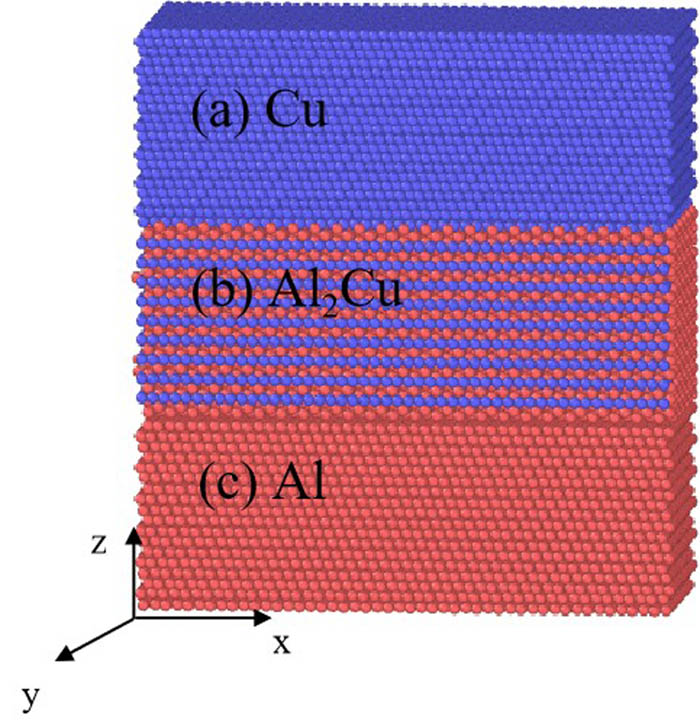
Cu/Al2Cu/Al multilayer structure: (a) Cu; (b) Al2Cu; (c) Al.
2.1 Uniaxial tensile model
The uniaxial tensile model is a four-prism, as shown in Figure 1. The X and Y-axis directions in the model represent free boundary conditions. The x-direction was [1
The initial orientation of Cu, Al and Al2Cu layers
| Layer | Axis | ||
|---|---|---|---|
| X | Y | Z | |
| Cu | [1
|
[10
|
[111] |
| Al | [1
|
[10
|
[111] |
| Al2Cu | [001] | [110] | [
|
In the complex model, the interatomic interactions of Cu–Cu, Al–Al, and Cu–Al used a bond order potential [21]. The time step of the simulation process was 0.001 ps. The model was initially relaxed for 50 ps under an isothermal and isobaric (NPT) ensemble, so the model temperature stabilized at 300 K, and the energy was minimized. Then, the model was subjected to uniaxial tensile deformation. Simulation results were obtained using the Open Visualization Tool (OVITO) software, and the results of the microstructure analysis were completed based on the Discontinuities Extraction Algorithm (DXA). Atoms of FCC, HCP, BCC, and unknown structural types are shown in green, red, blue, and white, respectively.
3 Results and discussion
The stress–strain curve of the vertical interface tensile deformation is shown in Figure 2. On the stress–strain curve, there are two stages of deformation. In the first stage of stretching, the material initially undergoes elastic deformation with an almost linear stress–strain curve (section AB). When the strain increases to 0.068 (point B), the material enters the yield stage with an initial yield strength of 7.23 GPa. When the strain increases to 0.085, the stress maximizes (point D) and decreases sharply with the onset of plastic deformation. Deformation in the second stage, the curve of the fluctuations in the growth stage (Section FG) appears as a twofold yield, with increases in strain, and stress begins to rise again to the second peak point ε = 0.199, σ = 3.25 GPa. As the strain increases, the stress–strain curve on the first platform in a relatively short (GH) fell to near M after stress.
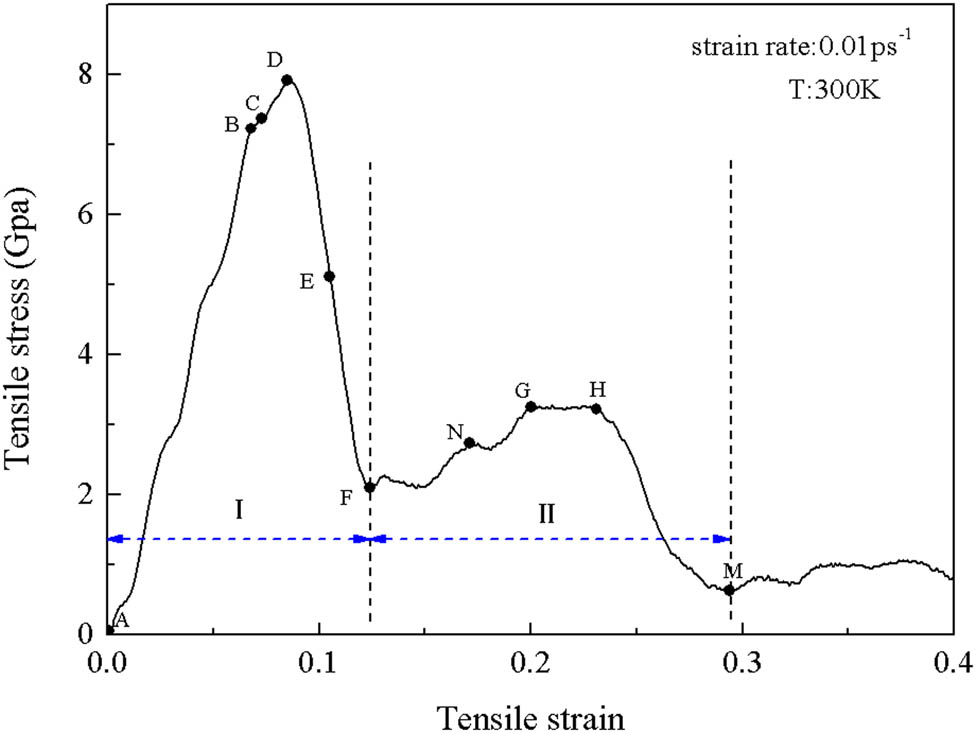
Stress–strain curve of Cu/Al2Cu/Al interface system under vertical interface tensile load.
3.1 Analysis of uniaxial tensile processes
Figure 3 shows the atomic structure evolution of the model in the I stage of uniaxial tensile deformation. The common neighbor atomic analysis in the OVITO software was used to color the atoms. In the initial deformation stage, the stress increased linearly as the strain increased. At this stage, the composite material was deformed elastically, and the atoms in the interface configuration were arranged neatly with almost no dislocation. As the strain increased further, as shown in Figure 3(b), dislocations began to nucleate at the heterogeneous interface between Cu and Al2Cu, and activation of the microscopic deformation system was first observed in the Cu layer. When the strain increases to 0.072, the heteroboundary arches out the 1/6 〈112〉 Shockley incomplete dislocation on the Cu side, and the dislocation moves along the {111} inside the Cu layer. At the same time, the dislocation starts nucleation at the heterointerface between Al and Al2Cu. At a strain of 0.085 (Figure 3(a)) in the deformation stage of the peak stress, the heteroboundary arches out 1/6 〈112〉 Shockley incomplete dislocation on the Al side. Due to the stress concentration at the heterogeneous interface, the dislocation nucleates at the interface and expands toward Cu and Al layers, which are prone to slip. The model then enters the plastic deformation stage. When the strain is 0.107, the 1/6 〈112〉 Shockley incomplete dislocation penetrates the Cu and Al layers and leaves an insertion type dislocation (Figure 3(e)).
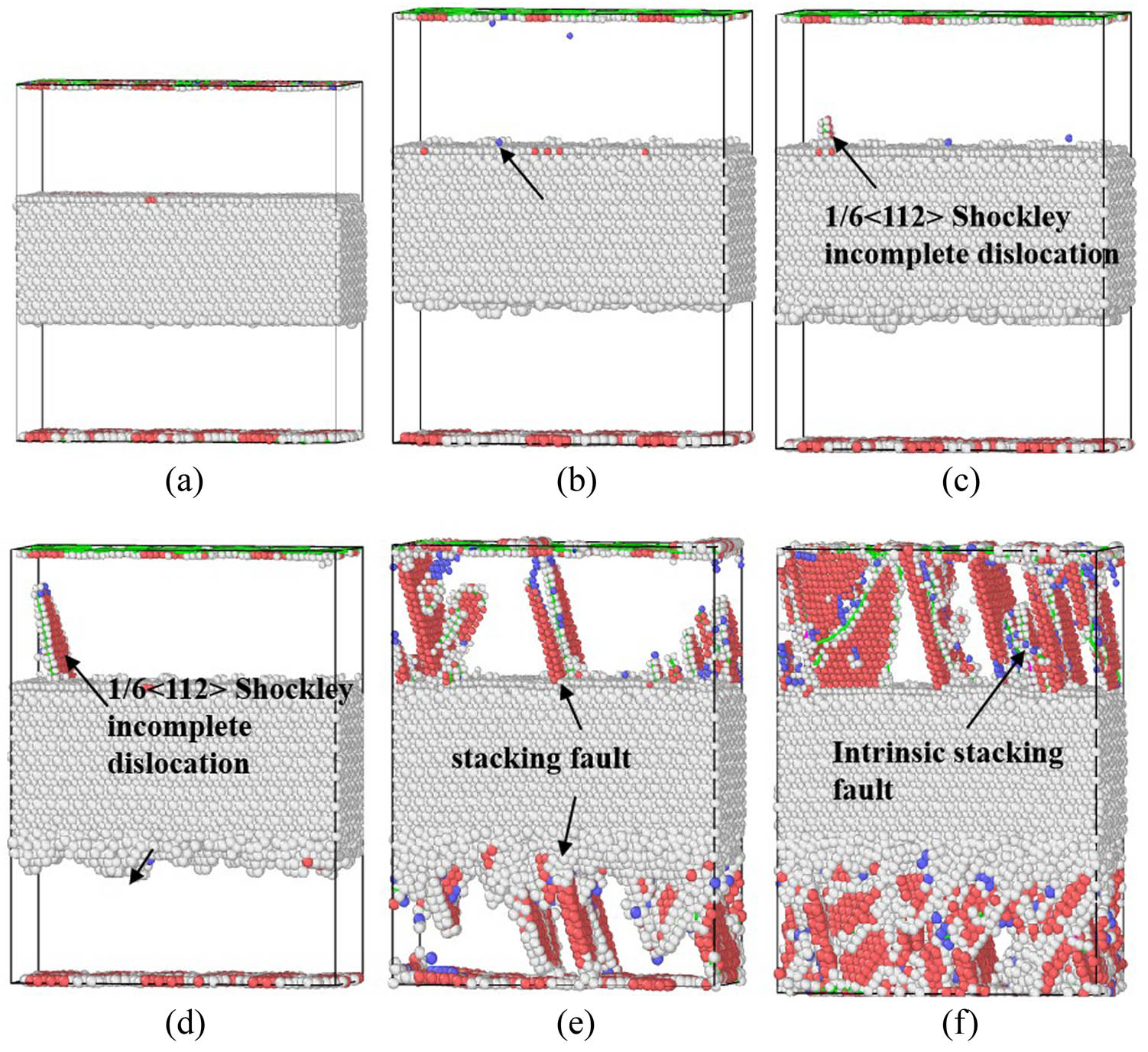
The Cu(111)/Al2Cu(
Figure 4 shows the atomic structure corresponding to each marked point of the stress–strain curve at the II stage of Cu(111)/Al2Cu(
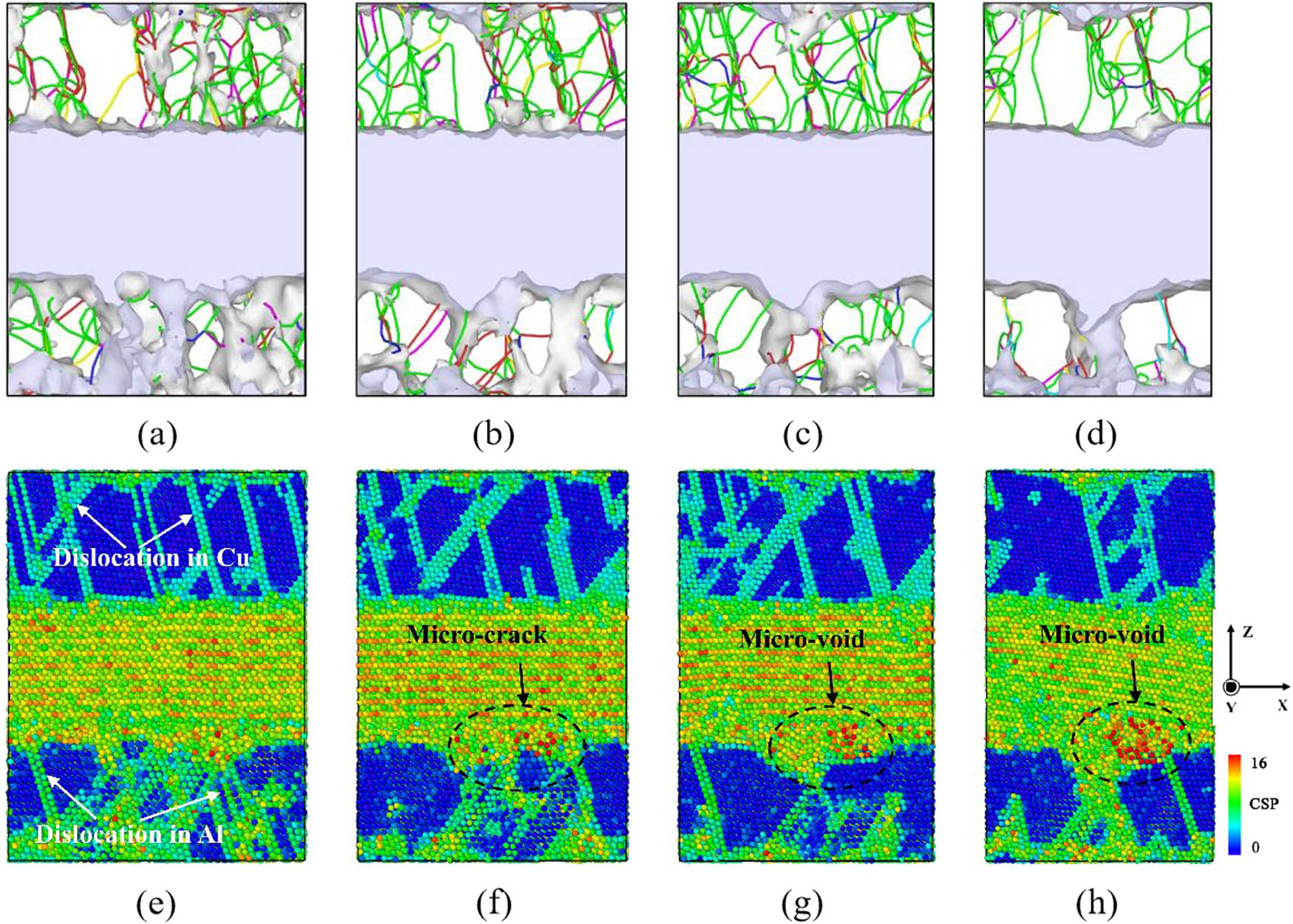
The Cu(111)/Al2Cu(
3.2 Model analysis at different strain rates
To study the effect of strain rate on multilayer tensile deformations, four different tensile simulation programs that corresponded to four different engineering strain rates were conducted. Programs using different strain rates needed different time steps so that the final strain of the entire is equaled to 0.30. Specific parameter settings are shown in Table 3. Their stress–strain curves at 300 K are shown in Figure 5.
Parameter settings under speed variables
| Strain rate (ps−1) | Relaxation time (ps) | Step length (ps) | Temperature (K) | Time step |
|---|---|---|---|---|
| 0.0005 | 50 | 0.001 | 300 | 600,000 |
| 0.001 | 50 | 0.001 | 300 | 300,000 |
| 0.005 | 50 | 0.001 | 300 | 60,000 |
| 0.01 | 50 | 0.001 | 300 | 30,000 |
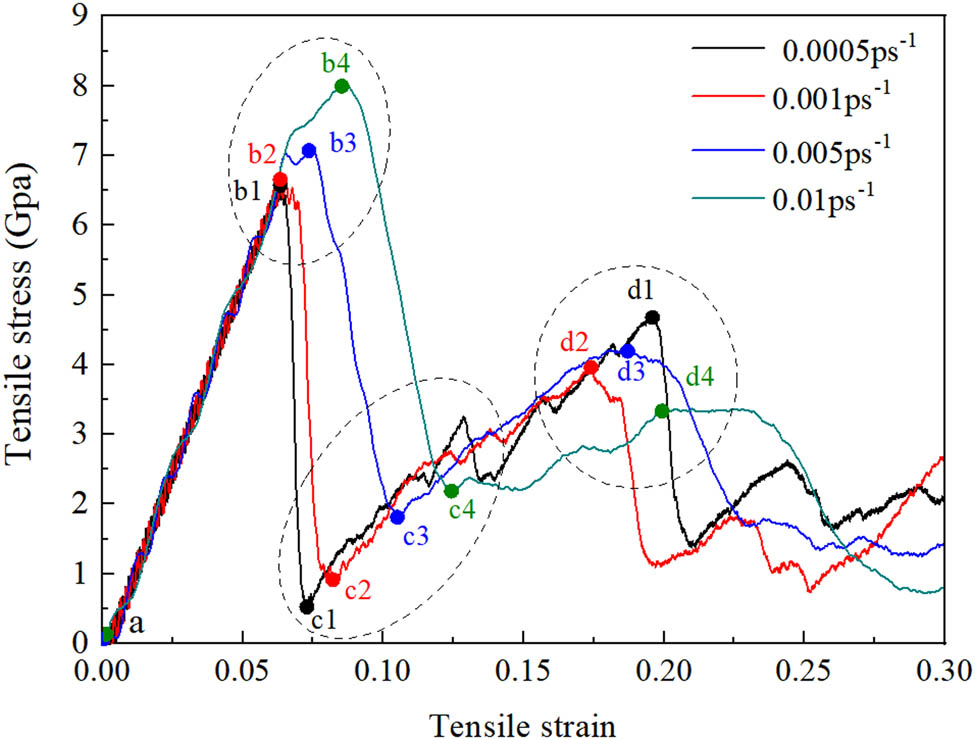
Stress–strain curves of different strain at 300 K.
For the tensile model of the vertical interface, the plastic deformation mechanism of the layered composites with different strain rates was also studied (Figure 5). According to those stress–strain curves, the mechanical behaviors of the models differed significantly under different strain rates. The stress increased linearly as the strain increased in the initial deformation stage, and the composite materials all underwent elastic deformation. The stress–strain curves at each strain rate were approximately coincident and had very similar slopes, which indicated the strain rate change had little effect on elastic deformation. In the range of simulated strain rate, the tensile strength of the composite showed a positive correlation to the engineering strain rate. When the strain rate was 0.0005 ps–1, the curves decline rapidly, but that declined slowed as the strain rate increased.
On the one hand, face-centered cubic aluminum had higher strain rate sensitivity due to the number of dislocation movements. The strength of copper with low stacking fault energy was augmented by the formation of a lamellar twin structure [22]. On the other hand, as an intermediate transition phase between the copper and aluminum layers, the Al2Cu layer has a good continuous structure. The Al2Cu layer provides a good fracture transition during tensile deformation, so the overall structure of the model with different ductility deformed at the same time until it broke. Therefore, within the strain rate range, the tensile strength of the composite material increased with the strain rate increase.
Figure 6 shows the dislocation line distribution at the inflection point of the stress–strain curves at different strain rates, and DXA analyzed the dislocation line distribution during tensile. The green line represents the 1/6 〈112〉 dislocation line, and the blue line represents the 1/2 〈110〉 dislocation line. The exact dislocation line assigned to the red line is uncertain. In the unstretched state, no dislocation lines were generated in the interface model (Figure 6(a), (e), (i), and (m)).
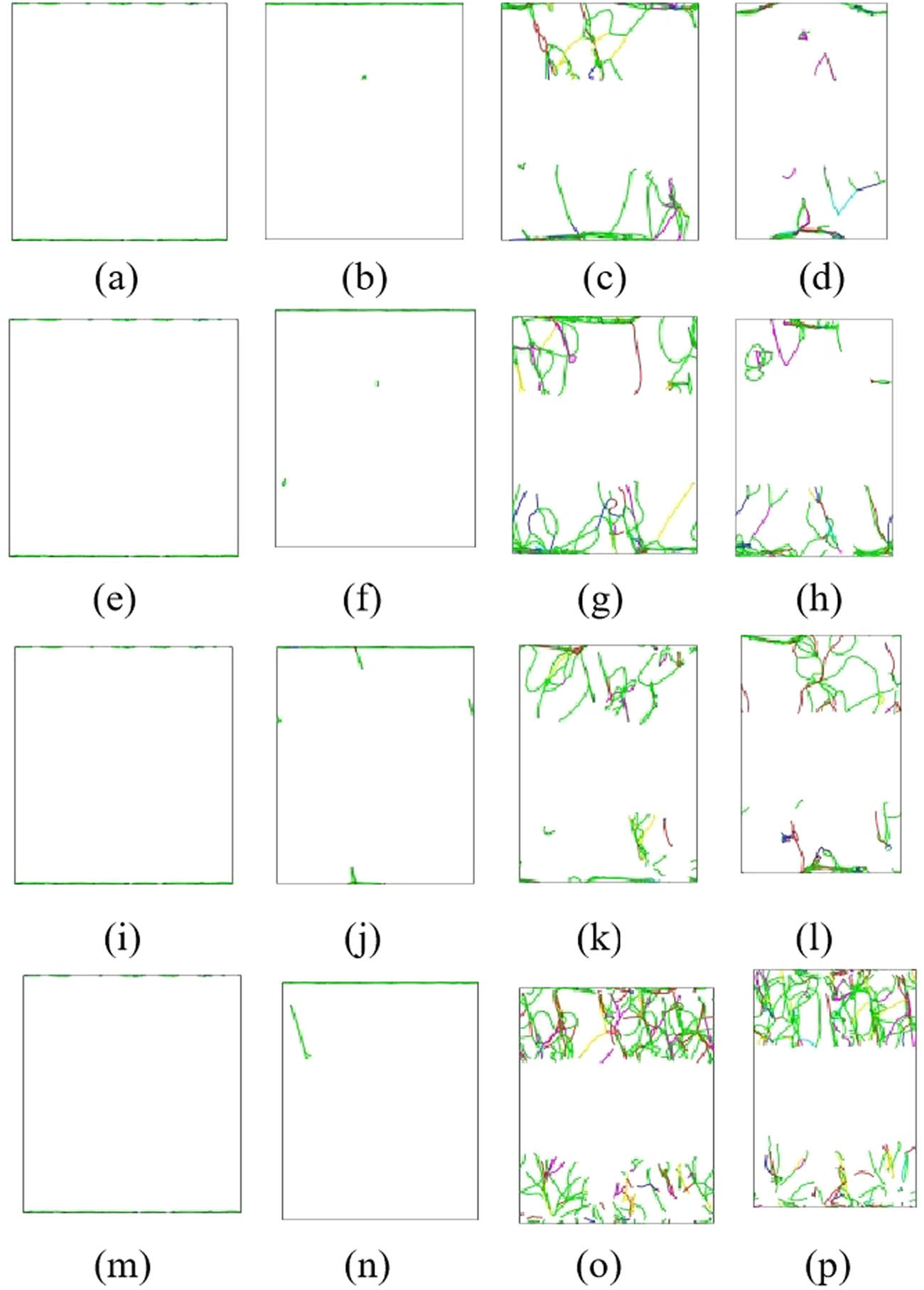
The distribution of the dislocation lines with respect to the marked points in the stress–strain curve (Figure 5). (a–d) 0.0005 ps−1; (e)–(h) 0.001 ps−1; (i–l) 0.005 ps−1; and (m–p) 0.01 ps−1. (a) point a1, (b) point b1, (c) point c1, (d) point d1, (e) point a2, (f) point b2, (g) point c2, (h) point d2, (i) point a3, (j) point b3, (k) point c3, (l) point d3, , (m) point a4, (n) point b4, (o) point c4, (p) point d4.
At a low strain rate, as the strain increases, the malposition in the composite body first occurs at point b (Figure 6(b) and (f)) and then maximizes at point c. On the one hand, the strength of the material plateaus at the yield stage when dislocations first occur. As the number of dislocation lines increases, the internal defects of the material increase, and the strength of the composite decreases. On the other hand, as the density of dislocations increases, the probability of simultaneous activation of dislocations in one direction decreases, and the mutual influence and staggering between dislocations make it difficult to move. This results in dislocation pinning, and the strength increases (Figure 5c and d segment).
Under different strain rates, the strength is independent of the strain rate in the initial strain stage. Strain rate hardening occurs when dislocations appear and the density of dislocations increases. The strength of the material increases as the strain rate increases and is consistent with literature reports [22–24].
3.3 Influence of temperature on tensile deformation
To study the influence of the temperature on the tensile deformation mechanical properties of Cu(111)/Al2Cu(
Figure 7 shows the stress–strain curves at different temperatures. The curves for all four temperatures showed similar trends; the deformation mechanism remained significantly unchanged from 100 to 700 K. Figure 8 shows the ultimate tensile strength at different temperatures. Higher temperatures resulted in a smaller ultimate stretch. This shows that temperature had almost no effect on Young’s modulus of the composite material, but the tensile strength and yield strain of the material gradually decreased at a higher temperature. Figure 9 shows the local strain distribution of the Cu(111)/Al2Cu(
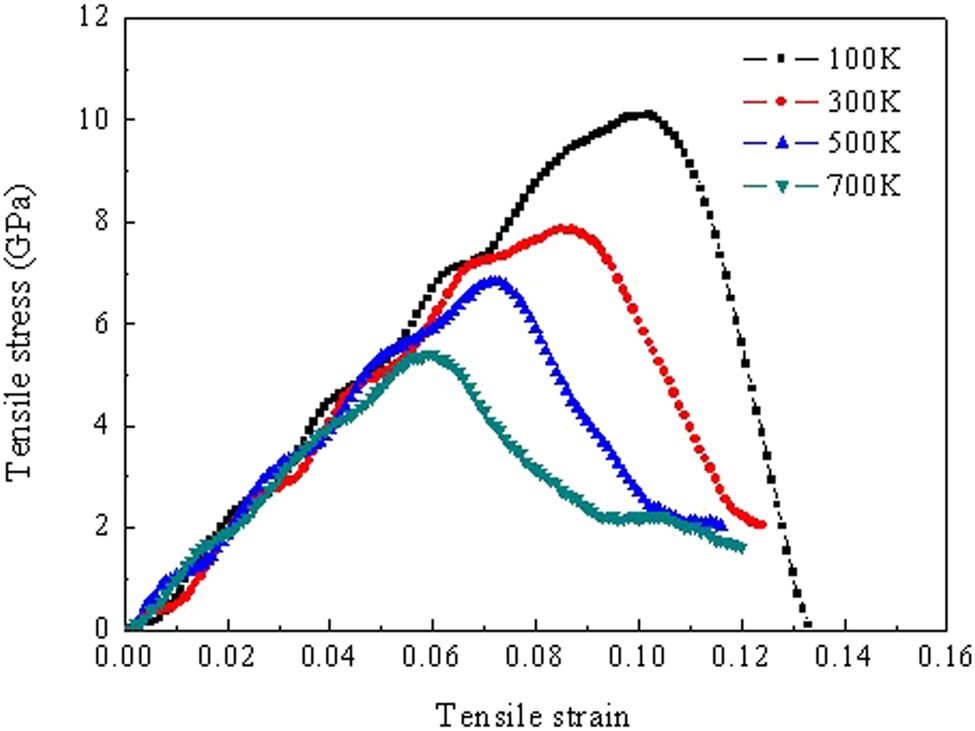
Stress–strain curves of the Cu(111)/Al2Cu(
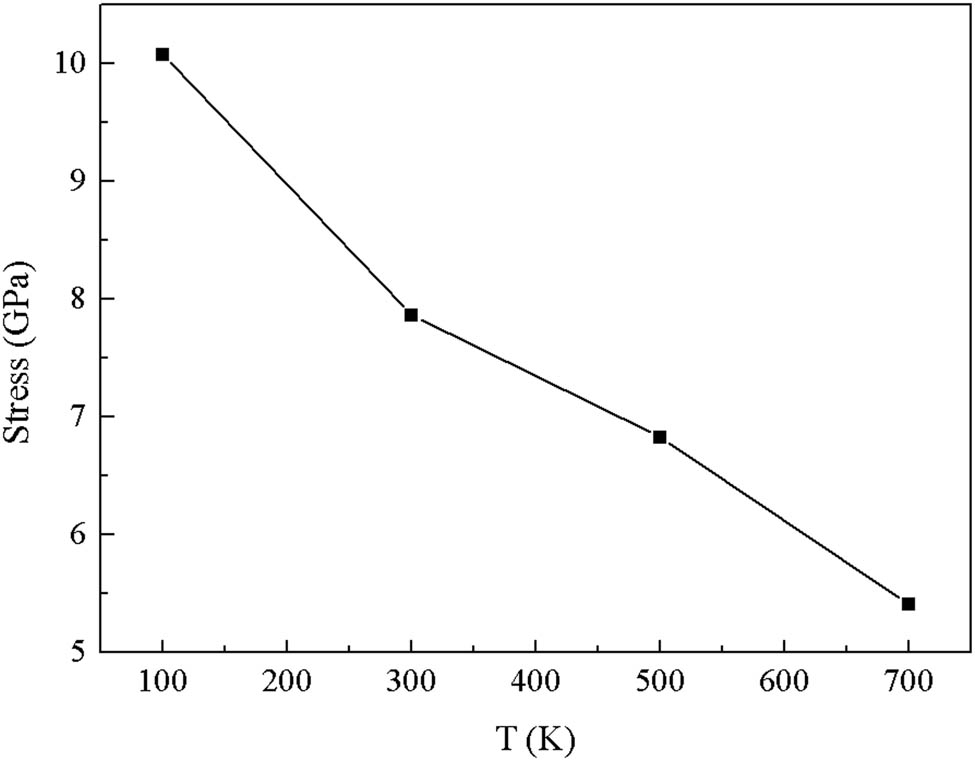
Ultimate tensile strength curves at different temperatures.
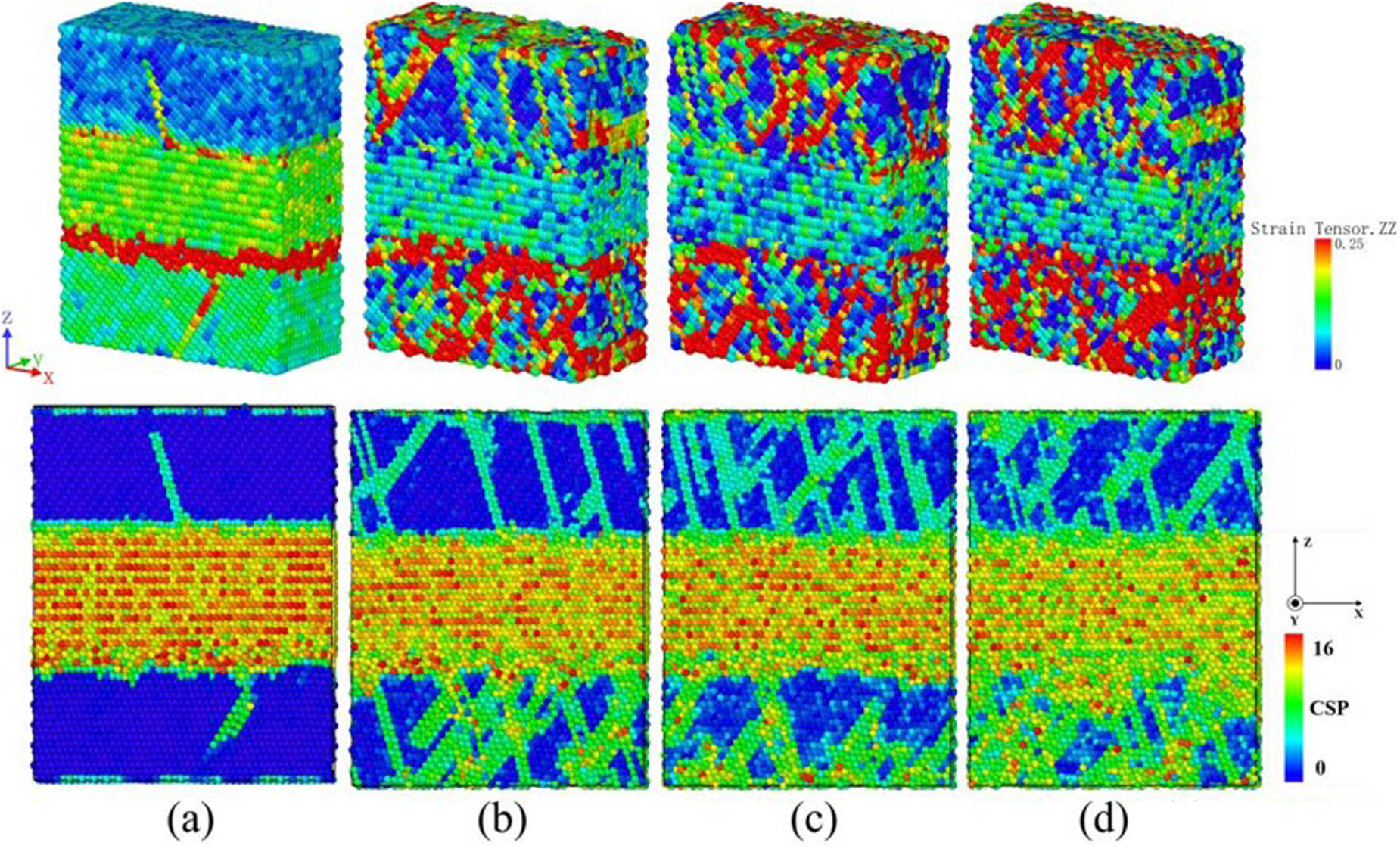
The distribution of the local plastic deformation and evolution of atomic configuration of the Cu(111)/Al2Cu(
Figure 9 displays the evolution of the atomic configurations of the interface model at different temperatures. At 500 K and 700 K, the atoms existed in thermally activated states, as shown in Figure 9(c) and (d). With temperature increase, some point defects were observed in the initial unstressed state, and as the strain increased, the number of point defects also increased, leading to the formation of microcracks. At the same time, the increase in temperature increased the amount of activated movable dislocations. Consequently, high-density dislocations hindered the growth of microcracks and increased the deformation resistance of the material, thus decreasing the plasticity of the material. This decrease in plasticity allows high-temperature conditions to promote dislocation nucleation.
4 Conclusion
The molecular dynamics simulations of uniaxial stretching of nano-layered Cu/Al composites containing brittle phase Al2Cu were studied. The effects of temperature and strain rate on the tensile deformation of the system were studied in-depth, as well as the Al/Al2Cu/Cu interface reaction. The following conclusions were drawn:
Under the tensile load of the Cu/Al2Cu/Al interface, dislocations preferentially nucleated at the Cu/Al2Cu heterogeneous interface and moved along the {111} crystal plane inside the Cu layer. The deformation mechanism was constrained slip within the layer. During this deformation, no initiation of plastic deformation occurred in the Al2Cu layer.
The presence of the Al2Cu layer made the overall structure deform at the same time, despite differences in strength and ductility.
The deformation mechanism remained basically unchanged from 100 to 700 K. Temperature has almost no effect on Young’s modulus of the composite material; however, as the temperature increased, the tensile strength and yield strain of the material gradually declined.
-
Funding information: This research has been supported by the China’s National Key R&D Program during the 14th five-year plan period (Grant No. 2021YFB3701304).
-
Author contributions: All authors have accepted responsibility for the entire content of this manuscript and approved its submission.
-
Conflict of interest: Authors state no conflict of interest.
References
[1] Liu G, Wang Q, Shang Z, Luo L, Ye B, Jiang H, et al. An investigation on microstructures and mechanical properties of ultra-low Cu layer thickness ratio Cu/8011/1060 clads. Metall Mater Trans A. 2019;50(12):5866–76.10.1007/s11661-019-05483-8Suche in Google Scholar
[2] Liu T, Wang Q, Sui Y, Wang Q, Ding W. An investigation into interface formation and mechanical properties of aluminum-copper bimetal by squeeze casting. Mater Des. 2016;89:1137–46.10.1016/j.matdes.2015.10.072Suche in Google Scholar
[3] Sheng LY, Yang F, Xi TF, Lai C, Ye HQ. Influence of heat treatment on interface of Cu/Al bimetal composite fabricated by cold rolling. Compos Part B. 2011;42(6):1468–73.10.1016/j.compositesb.2011.04.045Suche in Google Scholar
[4] Liu GP, Wang QD, Zhang L, Ye B, Jiang HY, Ding WJ. Effect of cooling rate on the microstructure and mechanical properties of Cu/Al bimetal fabricated by compound casting. Metall Mater Trans A. 2018;49(2):661–72.10.1007/s11661-017-4427-9Suche in Google Scholar
[5] Jin T, Li G, Cao Y, Xu R, Shao S, Yang B. Experimental research on applying the copper-clad aluminum tube as connecting tubes of air conditioners. Energy Build. 2015;97:1–5.10.1016/j.enbuild.2015.03.023Suche in Google Scholar
[6] Manesh HD, Taheri AK. The effect of annealing treatment on mechanical properties of aluminum clad steel sheet. Mater Des. 2003;24(8):617–22.10.1016/S0261-3069(03)00135-3Suche in Google Scholar
[7] Kim WN, Hong SI. Interactive deformation and enhanced ductility of tri-layered Cu/Al/Cu clad composite. Mater Sci Eng A. 2016;651:976–86.10.1016/j.msea.2015.11.062Suche in Google Scholar
[8] Liu S, Wang A, Tian H, Xie J. The synergetic tensile deformation behavior of Cu/Al laminated composites prepared by twin-roll casting technology. Mater Res Express. 2019;6(1):016530.10.1088/2053-1591/aae630Suche in Google Scholar
[9] Liu SY, Wang AQ, Lu SJ, Xie JP. High-performance Cu/Al laminated composites fabricated by horizontal twin-roll casting. Materialwiss Werkstofftech. 2018;49(10):1213–23.10.1002/mawe.201700217Suche in Google Scholar
[10] Hug E, Bellido N. Brittleness study of intermetallic (Cu, Al) layers in copper-clad aluminium thin wires. Mater Sci Eng A. 2011;528(22–23):22–3.10.1016/j.msea.2011.05.077Suche in Google Scholar
[11] Xu B, Tong WP, Liu CZ, Zhang H, Zuo L, He JC. Effect of high magnetic field on growth behavior of compound layers during reactive diffusion between solid Cu and liquid Al. J Mater Sci Technol. 2011;27(9):856–60.10.1016/S1005-0302(11)60155-2Suche in Google Scholar
[12] Han Y, Ben L, Yao J, Wu C. Microstructural characterization of Cu/Al composites and effect of cooling rate at the Cu/Al interfacial region. Int J Miner Metall Mater. 2015;22(1):94–101.10.1007/s12613-015-1048-4Suche in Google Scholar
[13] Rezaei R. Tensile mechanical characteristics and deformation mechanism of metal-graphene nanolayered composites. Comput Mater Sci. 2018;151:181–8.10.1016/j.commatsci.2018.05.004Suche in Google Scholar
[14] Yang W, Ayoub G, Salehinia I, Mansoor B, Zbib H. Deformation mechanisms in Ti/TiN multilayer under compressive loading. Acta Mater. 2017;122:99–108.10.1016/j.actamat.2016.09.039Suche in Google Scholar
[15] Zhou Q, Li S, Huang P, Xu KW, Wang F, Lu TJ. Strengthening mechanism of super-hard nanoscale Cu/Al multilayers with negative enthalpy of mixing. APL Mater. 2016;4(9):096102.10.1063/1.4962146Suche in Google Scholar
[16] Weng S, Ning H, Fu T, Hu N, Zhao Y, Huang C, et al. Molecular dynamics study of strengthening mechanism of nanolaminated graphene/Cu composites under compression. Sci Rep. 2018;8(1):3089.10.1038/s41598-018-21390-1Suche in Google Scholar PubMed PubMed Central
[17] Xu H, Liu C, Silberschmidt VV, Pramana SS, White TJ, Chen Z, et al. Behavior of aluminum oxide, intermetallics and voids in Cu–Al wire bonds. Acta Mater. 2011;59(14):5661–73.10.1016/j.actamat.2011.05.041Suche in Google Scholar
[18] Gao K, Li S, Xu L, Fu H. Effect of sample size on intermetallic Al2Cu microstructure and orientation evolution during directional solidification. J Cryst Growth. 2014;394:89–96.10.1016/j.jcrysgro.2014.02.023Suche in Google Scholar
[19] Shin D, Shyam A, Lee S, Yamamoto Y, Haynes JA. Solute segregation at the Al/θ′–Al2Cu interface in Al–Cu alloys. Acta Mater. 2017;141:327–40.10.1016/j.actamat.2017.09.020Suche in Google Scholar
[20] Zhou Q, Jian W, Misra A, Ping H, Xu K. Atomistic study of fundamental character and motion of dislocationsin intermetallic Al2Cu. Int J Plast. 2016;87:100–13.10.1016/j.ijplas.2016.09.005Suche in Google Scholar
[21] Zhou XW, Ward DK, Foster ME. An analytical bond-order potential for the aluminum copper binary system. J Alloys Compd. 2016;680:752–67.10.1016/j.jallcom.2016.04.055Suche in Google Scholar
[22] Li X, Zu G, Wang P. Effect of strain rate on tensile performance of Al/Cu/Al laminated composites produced by asymmetrical roll bonding. Mater Sci Eng A. 2013;575:61–4.10.1016/j.msea.2013.03.056Suche in Google Scholar
[23] Fan H, Wang Q, El-Awady JA, Raabe D, Zaiser M. Strain rate dependency of dislocation plasticity. Nat Commun. 2020;12:1845.10.1038/s41467-021-21939-1Suche in Google Scholar PubMed PubMed Central
[24] Niu JJ, Zhang JY, Liu G, Zhang P, Lei SY, Zhang GJ, et al. Size-dependent deformation mechanisms and strain-rate sensitivity in nanostructured Cu/X (X = Cr, Zr) multilayer films. Acta Mater. 2012;60(9):3677–89.10.1016/j.actamat.2012.03.052Suche in Google Scholar
© 2022 Yao Chen et al., published by De Gruyter
This work is licensed under the Creative Commons Attribution 4.0 International License.
Artikel in diesem Heft
- Research Articles
- Theoretical and experimental investigation of MWCNT dispersion effect on the elastic modulus of flexible PDMS/MWCNT nanocomposites
- Mechanical, morphological, and fracture-deformation behavior of MWCNTs-reinforced (Al–Cu–Mg–T351) alloy cast nanocomposites fabricated by optimized mechanical milling and powder metallurgy techniques
- Flammability and physical stability of sugar palm crystalline nanocellulose reinforced thermoplastic sugar palm starch/poly(lactic acid) blend bionanocomposites
- Glutathione-loaded non-ionic surfactant niosomes: A new approach to improve oral bioavailability and hepatoprotective efficacy of glutathione
- Relationship between mechano-bactericidal activity and nanoblades density on chemically strengthened glass
- In situ regulation of microstructure and microwave-absorbing properties of FeSiAl through HNO3 oxidation
- Research on a mechanical model of magnetorheological fluid different diameter particles
- Nanomechanical and dynamic mechanical properties of rubber–wood–plastic composites
- Investigative properties of CeO2 doped with niobium: A combined characterization and DFT studies
- Miniaturized peptidomimetics and nano-vesiculation in endothelin types through probable nano-disk formation and structure property relationships of endothelins’ fragments
- N/S co-doped CoSe/C nanocubes as anode materials for Li-ion batteries
- Synergistic effects of halloysite nanotubes with metal and phosphorus additives on the optimal design of eco-friendly sandwich panels with maximum flame resistance and minimum weight
- Octreotide-conjugated silver nanoparticles for active targeting of somatostatin receptors and their application in a nebulized rat model
- Controllable morphology of Bi2S3 nanostructures formed via hydrothermal vulcanization of Bi2O3 thin-film layer and their photoelectrocatalytic performances
- Development of (−)-epigallocatechin-3-gallate-loaded folate receptor-targeted nanoparticles for prostate cancer treatment
- Enhancement of the mechanical properties of HDPE mineral nanocomposites by filler particles modulation of the matrix plastic/elastic behavior
- Effect of plasticizers on the properties of sugar palm nanocellulose/cinnamon essential oil reinforced starch bionanocomposite films
- Optimization of nano coating to reduce the thermal deformation of ball screws
- Preparation of efficient piezoelectric PVDF–HFP/Ni composite films by high electric field poling
- MHD dissipative Casson nanofluid liquid film flow due to an unsteady stretching sheet with radiation influence and slip velocity phenomenon
- Effects of nano-SiO2 modification on rubberised mortar and concrete with recycled coarse aggregates
- Mechanical and microscopic properties of fiber-reinforced coal gangue-based geopolymer concrete
- Effect of morphology and size on the thermodynamic stability of cerium oxide nanoparticles: Experiment and molecular dynamics calculation
- Mechanical performance of a CFRP composite reinforced via gelatin-CNTs: A study on fiber interfacial enhancement and matrix enhancement
- A practical review over surface modification, nanopatterns, emerging materials, drug delivery systems, and their biophysiochemical properties for dental implants: Recent progresses and advances
- HTR: An ultra-high speed algorithm for cage recognition of clathrate hydrates
- Effects of microalloying elements added by in situ synthesis on the microstructure of WCu composites
- A highly sensitive nanobiosensor based on aptamer-conjugated graphene-decorated rhodium nanoparticles for detection of HER2-positive circulating tumor cells
- Progressive collapse performance of shear strengthened RC frames by nano CFRP
- Core–shell heterostructured composites of carbon nanotubes and imine-linked hyperbranched polymers as metal-free Li-ion anodes
- A Galerkin strategy for tri-hybridized mixture in ethylene glycol comprising variable diffusion and thermal conductivity using non-Fourier’s theory
- Simple models for tensile modulus of shape memory polymer nanocomposites at ambient temperature
- Preparation and morphological studies of tin sulfide nanoparticles and use as efficient photocatalysts for the degradation of rhodamine B and phenol
- Polyethyleneimine-impregnated activated carbon nanofiber composited graphene-derived rice husk char for efficient post-combustion CO2 capture
- Electrospun nanofibers of Co3O4 nanocrystals encapsulated in cyclized-polyacrylonitrile for lithium storage
- Pitting corrosion induced on high-strength high carbon steel wire in high alkaline deaerated chloride electrolyte
- Formulation of polymeric nanoparticles loaded sorafenib; evaluation of cytotoxicity, molecular evaluation, and gene expression studies in lung and breast cancer cell lines
- Engineered nanocomposites in asphalt binders
- Influence of loading voltage, domain ratio, and additional load on the actuation of dielectric elastomer
- Thermally induced hex-graphene transitions in 2D carbon crystals
- The surface modification effect on the interfacial properties of glass fiber-reinforced epoxy: A molecular dynamics study
- Molecular dynamics study of deformation mechanism of interfacial microzone of Cu/Al2Cu/Al composites under tension
- Nanocolloid simulators of luminescent solar concentrator photovoltaic windows
- Compressive strength and anti-chloride ion penetration assessment of geopolymer mortar merging PVA fiber and nano-SiO2 using RBF–BP composite neural network
- Effect of 3-mercapto-1-propane sulfonate sulfonic acid and polyvinylpyrrolidone on the growth of cobalt pillar by electrodeposition
- Dynamics of convective slippery constraints on hybrid radiative Sutterby nanofluid flow by Galerkin finite element simulation
- Preparation of vanadium by the magnesiothermic self-propagating reduction and process control
- Microstructure-dependent photoelectrocatalytic activity of heterogeneous ZnO–ZnS nanosheets
- Cytotoxic and pro-inflammatory effects of molybdenum and tungsten disulphide on human bronchial cells
- Improving recycled aggregate concrete by compression casting and nano-silica
- Chemically reactive Maxwell nanoliquid flow by a stretching surface in the frames of Newtonian heating, nonlinear convection and radiative flux: Nanopolymer flow processing simulation
- Nonlinear dynamic and crack behaviors of carbon nanotubes-reinforced composites with various geometries
- Biosynthesis of copper oxide nanoparticles and its therapeutic efficacy against colon cancer
- Synthesis and characterization of smart stimuli-responsive herbal drug-encapsulated nanoniosome particles for efficient treatment of breast cancer
- Homotopic simulation for heat transport phenomenon of the Burgers nanofluids flow over a stretching cylinder with thermal convective and zero mass flux conditions
- Incorporation of copper and strontium ions in TiO2 nanotubes via dopamine to enhance hemocompatibility and cytocompatibility
- Mechanical, thermal, and barrier properties of starch films incorporated with chitosan nanoparticles
- Mechanical properties and microstructure of nano-strengthened recycled aggregate concrete
- Glucose-responsive nanogels efficiently maintain the stability and activity of therapeutic enzymes
- Tunning matrix rheology and mechanical performance of ultra-high performance concrete using cellulose nanofibers
- Flexible MXene/copper/cellulose nanofiber heat spreader films with enhanced thermal conductivity
- Promoted charge separation and specific surface area via interlacing of N-doped titanium dioxide nanotubes on carbon nitride nanosheets for photocatalytic degradation of Rhodamine B
- Elucidating the role of silicon dioxide and titanium dioxide nanoparticles in mitigating the disease of the eggplant caused by Phomopsis vexans, Ralstonia solanacearum, and root-knot nematode Meloidogyne incognita
- An implication of magnetic dipole in Carreau Yasuda liquid influenced by engine oil using ternary hybrid nanomaterial
- Robust synthesis of a composite phase of copper vanadium oxide with enhanced performance for durable aqueous Zn-ion batteries
- Tunning self-assembled phases of bovine serum albumin via hydrothermal process to synthesize novel functional hydrogel for skin protection against UVB
- A comparative experimental study on damping properties of epoxy nanocomposite beams reinforced with carbon nanotubes and graphene nanoplatelets
- Lightweight and hydrophobic Ni/GO/PVA composite aerogels for ultrahigh performance electromagnetic interference shielding
- Research on the auxetic behavior and mechanical properties of periodically rotating graphene nanostructures
- Repairing performances of novel cement mortar modified with graphene oxide and polyacrylate polymer
- Closed-loop recycling and fabrication of hydrophilic CNT films with high performance
- Design of thin-film configuration of SnO2–Ag2O composites for NO2 gas-sensing applications
- Study on stress distribution of SiC/Al composites based on microstructure models with microns and nanoparticles
- PVDF green nanofibers as potential carriers for improving self-healing and mechanical properties of carbon fiber/epoxy prepregs
- Osteogenesis capability of three-dimensionally printed poly(lactic acid)-halloysite nanotube scaffolds containing strontium ranelate
- Silver nanoparticles induce mitochondria-dependent apoptosis and late non-canonical autophagy in HT-29 colon cancer cells
- Preparation and bonding mechanisms of polymer/metal hybrid composite by nano molding technology
- Damage self-sensing and strain monitoring of glass-reinforced epoxy composite impregnated with graphene nanoplatelet and multiwalled carbon nanotubes
- Thermal analysis characterisation of solar-powered ship using Oldroyd hybrid nanofluids in parabolic trough solar collector: An optimal thermal application
- Pyrene-functionalized halloysite nanotubes for simultaneously detecting and separating Hg(ii) in aqueous media: A comprehensive comparison on interparticle and intraparticle excimers
- Fabrication of self-assembly CNT flexible film and its piezoresistive sensing behaviors
- Thermal valuation and entropy inspection of second-grade nanoscale fluid flow over a stretching surface by applying Koo–Kleinstreuer–Li relation
- Mechanical properties and microstructure of nano-SiO2 and basalt-fiber-reinforced recycled aggregate concrete
- Characterization and tribology performance of polyaniline-coated nanodiamond lubricant additives
- Combined impact of Marangoni convection and thermophoretic particle deposition on chemically reactive transport of nanofluid flow over a stretching surface
- Spark plasma extrusion of binder free hydroxyapatite powder
- An investigation on thermo-mechanical performance of graphene-oxide-reinforced shape memory polymer
- Effect of nanoadditives on the novel leather fiber/recycled poly(ethylene-vinyl-acetate) polymer composites for multifunctional applications: Fabrication, characterizations, and multiobjective optimization using central composite design
- Design selection for a hemispherical dimple core sandwich panel using hybrid multi-criteria decision-making methods
- Improving tensile strength and impact toughness of plasticized poly(lactic acid) biocomposites by incorporating nanofibrillated cellulose
- Green synthesis of spinel copper ferrite (CuFe2O4) nanoparticles and their toxicity
- The effect of TaC and NbC hybrid and mono-nanoparticles on AA2024 nanocomposites: Microstructure, strengthening, and artificial aging
- Excited-state geometry relaxation of pyrene-modified cellulose nanocrystals under UV-light excitation for detecting Fe3+
- Effect of CNTs and MEA on the creep of face-slab concrete at an early age
- Effect of deformation conditions on compression phase transformation of AZ31
- Application of MXene as a new generation of highly conductive coating materials for electromembrane-surrounded solid-phase microextraction
- A comparative study of the elasto-plastic properties for ceramic nanocomposites filled by graphene or graphene oxide nanoplates
- Encapsulation strategies for improving the biological behavior of CdS@ZIF-8 nanocomposites
- Biosynthesis of ZnO NPs from pumpkin seeds’ extract and elucidation of its anticancer potential against breast cancer
- Preliminary trials of the gold nanoparticles conjugated chrysin: An assessment of anti-oxidant, anti-microbial, and in vitro cytotoxic activities of a nanoformulated flavonoid
- Effect of micron-scale pores increased by nano-SiO2 sol modification on the strength of cement mortar
- Fractional simulations for thermal flow of hybrid nanofluid with aluminum oxide and titanium oxide nanoparticles with water and blood base fluids
- The effect of graphene nano-powder on the viscosity of water: An experimental study and artificial neural network modeling
- Development of a novel heat- and shear-resistant nano-silica gelling agent
- Characterization, biocompatibility and in vivo of nominal MnO2-containing wollastonite glass-ceramic
- Entropy production simulation of second-grade magnetic nanomaterials flowing across an expanding surface with viscidness dissipative flux
- Enhancement in structural, morphological, and optical properties of copper oxide for optoelectronic device applications
- Aptamer-functionalized chitosan-coated gold nanoparticle complex as a suitable targeted drug carrier for improved breast cancer treatment
- Performance and overall evaluation of nano-alumina-modified asphalt mixture
- Analysis of pure nanofluid (GO/engine oil) and hybrid nanofluid (GO–Fe3O4/engine oil): Novel thermal and magnetic features
- Synthesis of Ag@AgCl modified anatase/rutile/brookite mixed phase TiO2 and their photocatalytic property
- Mechanisms and influential variables on the abrasion resistance hydraulic concrete
- Synergistic reinforcement mechanism of basalt fiber/cellulose nanocrystals/polypropylene composites
- Achieving excellent oxidation resistance and mechanical properties of TiB2–B4C/carbon aerogel composites by quick-gelation and mechanical mixing
- Microwave-assisted sol–gel template-free synthesis and characterization of silica nanoparticles obtained from South African coal fly ash
- Pulsed laser-assisted synthesis of nano nickel(ii) oxide-anchored graphitic carbon nitride: Characterizations and their potential antibacterial/anti-biofilm applications
- Effects of nano-ZrSi2 on thermal stability of phenolic resin and thermal reusability of quartz–phenolic composites
- Benzaldehyde derivatives on tin electroplating as corrosion resistance for fabricating copper circuit
- Mechanical and heat transfer properties of 4D-printed shape memory graphene oxide/epoxy acrylate composites
- Coupling the vanadium-induced amorphous/crystalline NiFe2O4 with phosphide heterojunction toward active oxygen evolution reaction catalysts
- Graphene-oxide-reinforced cement composites mechanical and microstructural characteristics at elevated temperatures
- Gray correlation analysis of factors influencing compressive strength and durability of nano-SiO2 and PVA fiber reinforced geopolymer mortar
- Preparation of layered gradient Cu–Cr–Ti alloy with excellent mechanical properties, thermal stability, and electrical conductivity
- Recovery of Cr from chrome-containing leather wastes to develop aluminum-based composite material along with Al2O3 ceramic particles: An ingenious approach
- Mechanisms of the improved stiffness of flexible polymers under impact loading
- Anticancer potential of gold nanoparticles (AuNPs) using a battery of in vitro tests
- Review Articles
- Proposed approaches for coronaviruses elimination from wastewater: Membrane techniques and nanotechnology solutions
- Application of Pickering emulsion in oil drilling and production
- The contribution of microfluidics to the fight against tuberculosis
- Graphene-based biosensors for disease theranostics: Development, applications, and recent advancements
- Synthesis and encapsulation of iron oxide nanorods for application in magnetic hyperthermia and photothermal therapy
- Contemporary nano-architectured drugs and leads for ανβ3 integrin-based chemotherapy: Rationale and retrospect
- State-of-the-art review of fabrication, application, and mechanical properties of functionally graded porous nanocomposite materials
- Insights on magnetic spinel ferrites for targeted drug delivery and hyperthermia applications
- A review on heterogeneous oxidation of acetaminophen based on micro and nanoparticles catalyzed by different activators
- Early diagnosis of lung cancer using magnetic nanoparticles-integrated systems
- Advances in ZnO: Manipulation of defects for enhancing their technological potentials
- Efficacious nanomedicine track toward combating COVID-19
- A review of the design, processes, and properties of Mg-based composites
- Green synthesis of nanoparticles for varied applications: Green renewable resources and energy-efficient synthetic routes
- Two-dimensional nanomaterial-based polymer composites: Fundamentals and applications
- Recent progress and challenges in plasmonic nanomaterials
- Apoptotic cell-derived micro/nanosized extracellular vesicles in tissue regeneration
- Electronic noses based on metal oxide nanowires: A review
- Framework materials for supercapacitors
- An overview on the reproductive toxicity of graphene derivatives: Highlighting the importance
- Antibacterial nanomaterials: Upcoming hope to overcome antibiotic resistance crisis
- Research progress of carbon materials in the field of three-dimensional printing polymer nanocomposites
- A review of atomic layer deposition modelling and simulation methodologies: Density functional theory and molecular dynamics
- Recent advances in the preparation of PVDF-based piezoelectric materials
- Recent developments in tensile properties of friction welding of carbon fiber-reinforced composite: A review
- Comprehensive review of the properties of fly ash-based geopolymer with additive of nano-SiO2
- Perspectives in biopolymer/graphene-based composite application: Advances, challenges, and recommendations
- Graphene-based nanocomposite using new modeling molecular dynamic simulations for proposed neutralizing mechanism and real-time sensing of COVID-19
- Nanotechnology application on bamboo materials: A review
- Recent developments and future perspectives of biorenewable nanocomposites for advanced applications
- Nanostructured lipid carrier system: A compendium of their formulation development approaches, optimization strategies by quality by design, and recent applications in drug delivery
- 3D printing customized design of human bone tissue implant and its application
- Design, preparation, and functionalization of nanobiomaterials for enhanced efficacy in current and future biomedical applications
- A brief review of nanoparticles-doped PEDOT:PSS nanocomposite for OLED and OPV
- Nanotechnology interventions as a putative tool for the treatment of dental afflictions
- Recent advancements in metal–organic frameworks integrating quantum dots (QDs@MOF) and their potential applications
- A focused review of short electrospun nanofiber preparation techniques for composite reinforcement
- Microstructural characteristics and nano-modification of interfacial transition zone in concrete: A review
- Latest developments in the upconversion nanotechnology for the rapid detection of food safety: A review
- Strategic applications of nano-fertilizers for sustainable agriculture: Benefits and bottlenecks
- Molecular dynamics application of cocrystal energetic materials: A review
- Synthesis and application of nanometer hydroxyapatite in biomedicine
- Cutting-edge development in waste-recycled nanomaterials for energy storage and conversion applications
- Biological applications of ternary quantum dots: A review
- Nanotherapeutics for hydrogen sulfide-involved treatment: An emerging approach for cancer therapy
- Application of antibacterial nanoparticles in orthodontic materials
- Effect of natural-based biological hydrogels combined with growth factors on skin wound healing
- Nanozymes – A route to overcome microbial resistance: A viewpoint
- Recent developments and applications of smart nanoparticles in biomedicine
- Contemporary review on carbon nanotube (CNT) composites and their impact on multifarious applications
- Interfacial interactions and reinforcing mechanisms of cellulose and chitin nanomaterials and starch derivatives for cement and concrete strength and durability enhancement: A review
- Diamond-like carbon films for tribological modification of rubber
- Layered double hydroxides (LDHs) modified cement-based materials: A systematic review
- Recent research progress and advanced applications of silica/polymer nanocomposites
- Modeling of supramolecular biopolymers: Leading the in silico revolution of tissue engineering and nanomedicine
- Recent advances in perovskites-based optoelectronics
- Biogenic synthesis of palladium nanoparticles: New production methods and applications
- A comprehensive review of nanofluids with fractional derivatives: Modeling and application
- Electrospinning of marine polysaccharides: Processing and chemical aspects, challenges, and future prospects
- Electrohydrodynamic printing for demanding devices: A review of processing and applications
- Rapid Communications
- Structural material with designed thermal twist for a simple actuation
- Recent advances in photothermal materials for solar-driven crude oil adsorption
Artikel in diesem Heft
- Research Articles
- Theoretical and experimental investigation of MWCNT dispersion effect on the elastic modulus of flexible PDMS/MWCNT nanocomposites
- Mechanical, morphological, and fracture-deformation behavior of MWCNTs-reinforced (Al–Cu–Mg–T351) alloy cast nanocomposites fabricated by optimized mechanical milling and powder metallurgy techniques
- Flammability and physical stability of sugar palm crystalline nanocellulose reinforced thermoplastic sugar palm starch/poly(lactic acid) blend bionanocomposites
- Glutathione-loaded non-ionic surfactant niosomes: A new approach to improve oral bioavailability and hepatoprotective efficacy of glutathione
- Relationship between mechano-bactericidal activity and nanoblades density on chemically strengthened glass
- In situ regulation of microstructure and microwave-absorbing properties of FeSiAl through HNO3 oxidation
- Research on a mechanical model of magnetorheological fluid different diameter particles
- Nanomechanical and dynamic mechanical properties of rubber–wood–plastic composites
- Investigative properties of CeO2 doped with niobium: A combined characterization and DFT studies
- Miniaturized peptidomimetics and nano-vesiculation in endothelin types through probable nano-disk formation and structure property relationships of endothelins’ fragments
- N/S co-doped CoSe/C nanocubes as anode materials for Li-ion batteries
- Synergistic effects of halloysite nanotubes with metal and phosphorus additives on the optimal design of eco-friendly sandwich panels with maximum flame resistance and minimum weight
- Octreotide-conjugated silver nanoparticles for active targeting of somatostatin receptors and their application in a nebulized rat model
- Controllable morphology of Bi2S3 nanostructures formed via hydrothermal vulcanization of Bi2O3 thin-film layer and their photoelectrocatalytic performances
- Development of (−)-epigallocatechin-3-gallate-loaded folate receptor-targeted nanoparticles for prostate cancer treatment
- Enhancement of the mechanical properties of HDPE mineral nanocomposites by filler particles modulation of the matrix plastic/elastic behavior
- Effect of plasticizers on the properties of sugar palm nanocellulose/cinnamon essential oil reinforced starch bionanocomposite films
- Optimization of nano coating to reduce the thermal deformation of ball screws
- Preparation of efficient piezoelectric PVDF–HFP/Ni composite films by high electric field poling
- MHD dissipative Casson nanofluid liquid film flow due to an unsteady stretching sheet with radiation influence and slip velocity phenomenon
- Effects of nano-SiO2 modification on rubberised mortar and concrete with recycled coarse aggregates
- Mechanical and microscopic properties of fiber-reinforced coal gangue-based geopolymer concrete
- Effect of morphology and size on the thermodynamic stability of cerium oxide nanoparticles: Experiment and molecular dynamics calculation
- Mechanical performance of a CFRP composite reinforced via gelatin-CNTs: A study on fiber interfacial enhancement and matrix enhancement
- A practical review over surface modification, nanopatterns, emerging materials, drug delivery systems, and their biophysiochemical properties for dental implants: Recent progresses and advances
- HTR: An ultra-high speed algorithm for cage recognition of clathrate hydrates
- Effects of microalloying elements added by in situ synthesis on the microstructure of WCu composites
- A highly sensitive nanobiosensor based on aptamer-conjugated graphene-decorated rhodium nanoparticles for detection of HER2-positive circulating tumor cells
- Progressive collapse performance of shear strengthened RC frames by nano CFRP
- Core–shell heterostructured composites of carbon nanotubes and imine-linked hyperbranched polymers as metal-free Li-ion anodes
- A Galerkin strategy for tri-hybridized mixture in ethylene glycol comprising variable diffusion and thermal conductivity using non-Fourier’s theory
- Simple models for tensile modulus of shape memory polymer nanocomposites at ambient temperature
- Preparation and morphological studies of tin sulfide nanoparticles and use as efficient photocatalysts for the degradation of rhodamine B and phenol
- Polyethyleneimine-impregnated activated carbon nanofiber composited graphene-derived rice husk char for efficient post-combustion CO2 capture
- Electrospun nanofibers of Co3O4 nanocrystals encapsulated in cyclized-polyacrylonitrile for lithium storage
- Pitting corrosion induced on high-strength high carbon steel wire in high alkaline deaerated chloride electrolyte
- Formulation of polymeric nanoparticles loaded sorafenib; evaluation of cytotoxicity, molecular evaluation, and gene expression studies in lung and breast cancer cell lines
- Engineered nanocomposites in asphalt binders
- Influence of loading voltage, domain ratio, and additional load on the actuation of dielectric elastomer
- Thermally induced hex-graphene transitions in 2D carbon crystals
- The surface modification effect on the interfacial properties of glass fiber-reinforced epoxy: A molecular dynamics study
- Molecular dynamics study of deformation mechanism of interfacial microzone of Cu/Al2Cu/Al composites under tension
- Nanocolloid simulators of luminescent solar concentrator photovoltaic windows
- Compressive strength and anti-chloride ion penetration assessment of geopolymer mortar merging PVA fiber and nano-SiO2 using RBF–BP composite neural network
- Effect of 3-mercapto-1-propane sulfonate sulfonic acid and polyvinylpyrrolidone on the growth of cobalt pillar by electrodeposition
- Dynamics of convective slippery constraints on hybrid radiative Sutterby nanofluid flow by Galerkin finite element simulation
- Preparation of vanadium by the magnesiothermic self-propagating reduction and process control
- Microstructure-dependent photoelectrocatalytic activity of heterogeneous ZnO–ZnS nanosheets
- Cytotoxic and pro-inflammatory effects of molybdenum and tungsten disulphide on human bronchial cells
- Improving recycled aggregate concrete by compression casting and nano-silica
- Chemically reactive Maxwell nanoliquid flow by a stretching surface in the frames of Newtonian heating, nonlinear convection and radiative flux: Nanopolymer flow processing simulation
- Nonlinear dynamic and crack behaviors of carbon nanotubes-reinforced composites with various geometries
- Biosynthesis of copper oxide nanoparticles and its therapeutic efficacy against colon cancer
- Synthesis and characterization of smart stimuli-responsive herbal drug-encapsulated nanoniosome particles for efficient treatment of breast cancer
- Homotopic simulation for heat transport phenomenon of the Burgers nanofluids flow over a stretching cylinder with thermal convective and zero mass flux conditions
- Incorporation of copper and strontium ions in TiO2 nanotubes via dopamine to enhance hemocompatibility and cytocompatibility
- Mechanical, thermal, and barrier properties of starch films incorporated with chitosan nanoparticles
- Mechanical properties and microstructure of nano-strengthened recycled aggregate concrete
- Glucose-responsive nanogels efficiently maintain the stability and activity of therapeutic enzymes
- Tunning matrix rheology and mechanical performance of ultra-high performance concrete using cellulose nanofibers
- Flexible MXene/copper/cellulose nanofiber heat spreader films with enhanced thermal conductivity
- Promoted charge separation and specific surface area via interlacing of N-doped titanium dioxide nanotubes on carbon nitride nanosheets for photocatalytic degradation of Rhodamine B
- Elucidating the role of silicon dioxide and titanium dioxide nanoparticles in mitigating the disease of the eggplant caused by Phomopsis vexans, Ralstonia solanacearum, and root-knot nematode Meloidogyne incognita
- An implication of magnetic dipole in Carreau Yasuda liquid influenced by engine oil using ternary hybrid nanomaterial
- Robust synthesis of a composite phase of copper vanadium oxide with enhanced performance for durable aqueous Zn-ion batteries
- Tunning self-assembled phases of bovine serum albumin via hydrothermal process to synthesize novel functional hydrogel for skin protection against UVB
- A comparative experimental study on damping properties of epoxy nanocomposite beams reinforced with carbon nanotubes and graphene nanoplatelets
- Lightweight and hydrophobic Ni/GO/PVA composite aerogels for ultrahigh performance electromagnetic interference shielding
- Research on the auxetic behavior and mechanical properties of periodically rotating graphene nanostructures
- Repairing performances of novel cement mortar modified with graphene oxide and polyacrylate polymer
- Closed-loop recycling and fabrication of hydrophilic CNT films with high performance
- Design of thin-film configuration of SnO2–Ag2O composites for NO2 gas-sensing applications
- Study on stress distribution of SiC/Al composites based on microstructure models with microns and nanoparticles
- PVDF green nanofibers as potential carriers for improving self-healing and mechanical properties of carbon fiber/epoxy prepregs
- Osteogenesis capability of three-dimensionally printed poly(lactic acid)-halloysite nanotube scaffolds containing strontium ranelate
- Silver nanoparticles induce mitochondria-dependent apoptosis and late non-canonical autophagy in HT-29 colon cancer cells
- Preparation and bonding mechanisms of polymer/metal hybrid composite by nano molding technology
- Damage self-sensing and strain monitoring of glass-reinforced epoxy composite impregnated with graphene nanoplatelet and multiwalled carbon nanotubes
- Thermal analysis characterisation of solar-powered ship using Oldroyd hybrid nanofluids in parabolic trough solar collector: An optimal thermal application
- Pyrene-functionalized halloysite nanotubes for simultaneously detecting and separating Hg(ii) in aqueous media: A comprehensive comparison on interparticle and intraparticle excimers
- Fabrication of self-assembly CNT flexible film and its piezoresistive sensing behaviors
- Thermal valuation and entropy inspection of second-grade nanoscale fluid flow over a stretching surface by applying Koo–Kleinstreuer–Li relation
- Mechanical properties and microstructure of nano-SiO2 and basalt-fiber-reinforced recycled aggregate concrete
- Characterization and tribology performance of polyaniline-coated nanodiamond lubricant additives
- Combined impact of Marangoni convection and thermophoretic particle deposition on chemically reactive transport of nanofluid flow over a stretching surface
- Spark plasma extrusion of binder free hydroxyapatite powder
- An investigation on thermo-mechanical performance of graphene-oxide-reinforced shape memory polymer
- Effect of nanoadditives on the novel leather fiber/recycled poly(ethylene-vinyl-acetate) polymer composites for multifunctional applications: Fabrication, characterizations, and multiobjective optimization using central composite design
- Design selection for a hemispherical dimple core sandwich panel using hybrid multi-criteria decision-making methods
- Improving tensile strength and impact toughness of plasticized poly(lactic acid) biocomposites by incorporating nanofibrillated cellulose
- Green synthesis of spinel copper ferrite (CuFe2O4) nanoparticles and their toxicity
- The effect of TaC and NbC hybrid and mono-nanoparticles on AA2024 nanocomposites: Microstructure, strengthening, and artificial aging
- Excited-state geometry relaxation of pyrene-modified cellulose nanocrystals under UV-light excitation for detecting Fe3+
- Effect of CNTs and MEA on the creep of face-slab concrete at an early age
- Effect of deformation conditions on compression phase transformation of AZ31
- Application of MXene as a new generation of highly conductive coating materials for electromembrane-surrounded solid-phase microextraction
- A comparative study of the elasto-plastic properties for ceramic nanocomposites filled by graphene or graphene oxide nanoplates
- Encapsulation strategies for improving the biological behavior of CdS@ZIF-8 nanocomposites
- Biosynthesis of ZnO NPs from pumpkin seeds’ extract and elucidation of its anticancer potential against breast cancer
- Preliminary trials of the gold nanoparticles conjugated chrysin: An assessment of anti-oxidant, anti-microbial, and in vitro cytotoxic activities of a nanoformulated flavonoid
- Effect of micron-scale pores increased by nano-SiO2 sol modification on the strength of cement mortar
- Fractional simulations for thermal flow of hybrid nanofluid with aluminum oxide and titanium oxide nanoparticles with water and blood base fluids
- The effect of graphene nano-powder on the viscosity of water: An experimental study and artificial neural network modeling
- Development of a novel heat- and shear-resistant nano-silica gelling agent
- Characterization, biocompatibility and in vivo of nominal MnO2-containing wollastonite glass-ceramic
- Entropy production simulation of second-grade magnetic nanomaterials flowing across an expanding surface with viscidness dissipative flux
- Enhancement in structural, morphological, and optical properties of copper oxide for optoelectronic device applications
- Aptamer-functionalized chitosan-coated gold nanoparticle complex as a suitable targeted drug carrier for improved breast cancer treatment
- Performance and overall evaluation of nano-alumina-modified asphalt mixture
- Analysis of pure nanofluid (GO/engine oil) and hybrid nanofluid (GO–Fe3O4/engine oil): Novel thermal and magnetic features
- Synthesis of Ag@AgCl modified anatase/rutile/brookite mixed phase TiO2 and their photocatalytic property
- Mechanisms and influential variables on the abrasion resistance hydraulic concrete
- Synergistic reinforcement mechanism of basalt fiber/cellulose nanocrystals/polypropylene composites
- Achieving excellent oxidation resistance and mechanical properties of TiB2–B4C/carbon aerogel composites by quick-gelation and mechanical mixing
- Microwave-assisted sol–gel template-free synthesis and characterization of silica nanoparticles obtained from South African coal fly ash
- Pulsed laser-assisted synthesis of nano nickel(ii) oxide-anchored graphitic carbon nitride: Characterizations and their potential antibacterial/anti-biofilm applications
- Effects of nano-ZrSi2 on thermal stability of phenolic resin and thermal reusability of quartz–phenolic composites
- Benzaldehyde derivatives on tin electroplating as corrosion resistance for fabricating copper circuit
- Mechanical and heat transfer properties of 4D-printed shape memory graphene oxide/epoxy acrylate composites
- Coupling the vanadium-induced amorphous/crystalline NiFe2O4 with phosphide heterojunction toward active oxygen evolution reaction catalysts
- Graphene-oxide-reinforced cement composites mechanical and microstructural characteristics at elevated temperatures
- Gray correlation analysis of factors influencing compressive strength and durability of nano-SiO2 and PVA fiber reinforced geopolymer mortar
- Preparation of layered gradient Cu–Cr–Ti alloy with excellent mechanical properties, thermal stability, and electrical conductivity
- Recovery of Cr from chrome-containing leather wastes to develop aluminum-based composite material along with Al2O3 ceramic particles: An ingenious approach
- Mechanisms of the improved stiffness of flexible polymers under impact loading
- Anticancer potential of gold nanoparticles (AuNPs) using a battery of in vitro tests
- Review Articles
- Proposed approaches for coronaviruses elimination from wastewater: Membrane techniques and nanotechnology solutions
- Application of Pickering emulsion in oil drilling and production
- The contribution of microfluidics to the fight against tuberculosis
- Graphene-based biosensors for disease theranostics: Development, applications, and recent advancements
- Synthesis and encapsulation of iron oxide nanorods for application in magnetic hyperthermia and photothermal therapy
- Contemporary nano-architectured drugs and leads for ανβ3 integrin-based chemotherapy: Rationale and retrospect
- State-of-the-art review of fabrication, application, and mechanical properties of functionally graded porous nanocomposite materials
- Insights on magnetic spinel ferrites for targeted drug delivery and hyperthermia applications
- A review on heterogeneous oxidation of acetaminophen based on micro and nanoparticles catalyzed by different activators
- Early diagnosis of lung cancer using magnetic nanoparticles-integrated systems
- Advances in ZnO: Manipulation of defects for enhancing their technological potentials
- Efficacious nanomedicine track toward combating COVID-19
- A review of the design, processes, and properties of Mg-based composites
- Green synthesis of nanoparticles for varied applications: Green renewable resources and energy-efficient synthetic routes
- Two-dimensional nanomaterial-based polymer composites: Fundamentals and applications
- Recent progress and challenges in plasmonic nanomaterials
- Apoptotic cell-derived micro/nanosized extracellular vesicles in tissue regeneration
- Electronic noses based on metal oxide nanowires: A review
- Framework materials for supercapacitors
- An overview on the reproductive toxicity of graphene derivatives: Highlighting the importance
- Antibacterial nanomaterials: Upcoming hope to overcome antibiotic resistance crisis
- Research progress of carbon materials in the field of three-dimensional printing polymer nanocomposites
- A review of atomic layer deposition modelling and simulation methodologies: Density functional theory and molecular dynamics
- Recent advances in the preparation of PVDF-based piezoelectric materials
- Recent developments in tensile properties of friction welding of carbon fiber-reinforced composite: A review
- Comprehensive review of the properties of fly ash-based geopolymer with additive of nano-SiO2
- Perspectives in biopolymer/graphene-based composite application: Advances, challenges, and recommendations
- Graphene-based nanocomposite using new modeling molecular dynamic simulations for proposed neutralizing mechanism and real-time sensing of COVID-19
- Nanotechnology application on bamboo materials: A review
- Recent developments and future perspectives of biorenewable nanocomposites for advanced applications
- Nanostructured lipid carrier system: A compendium of their formulation development approaches, optimization strategies by quality by design, and recent applications in drug delivery
- 3D printing customized design of human bone tissue implant and its application
- Design, preparation, and functionalization of nanobiomaterials for enhanced efficacy in current and future biomedical applications
- A brief review of nanoparticles-doped PEDOT:PSS nanocomposite for OLED and OPV
- Nanotechnology interventions as a putative tool for the treatment of dental afflictions
- Recent advancements in metal–organic frameworks integrating quantum dots (QDs@MOF) and their potential applications
- A focused review of short electrospun nanofiber preparation techniques for composite reinforcement
- Microstructural characteristics and nano-modification of interfacial transition zone in concrete: A review
- Latest developments in the upconversion nanotechnology for the rapid detection of food safety: A review
- Strategic applications of nano-fertilizers for sustainable agriculture: Benefits and bottlenecks
- Molecular dynamics application of cocrystal energetic materials: A review
- Synthesis and application of nanometer hydroxyapatite in biomedicine
- Cutting-edge development in waste-recycled nanomaterials for energy storage and conversion applications
- Biological applications of ternary quantum dots: A review
- Nanotherapeutics for hydrogen sulfide-involved treatment: An emerging approach for cancer therapy
- Application of antibacterial nanoparticles in orthodontic materials
- Effect of natural-based biological hydrogels combined with growth factors on skin wound healing
- Nanozymes – A route to overcome microbial resistance: A viewpoint
- Recent developments and applications of smart nanoparticles in biomedicine
- Contemporary review on carbon nanotube (CNT) composites and their impact on multifarious applications
- Interfacial interactions and reinforcing mechanisms of cellulose and chitin nanomaterials and starch derivatives for cement and concrete strength and durability enhancement: A review
- Diamond-like carbon films for tribological modification of rubber
- Layered double hydroxides (LDHs) modified cement-based materials: A systematic review
- Recent research progress and advanced applications of silica/polymer nanocomposites
- Modeling of supramolecular biopolymers: Leading the in silico revolution of tissue engineering and nanomedicine
- Recent advances in perovskites-based optoelectronics
- Biogenic synthesis of palladium nanoparticles: New production methods and applications
- A comprehensive review of nanofluids with fractional derivatives: Modeling and application
- Electrospinning of marine polysaccharides: Processing and chemical aspects, challenges, and future prospects
- Electrohydrodynamic printing for demanding devices: A review of processing and applications
- Rapid Communications
- Structural material with designed thermal twist for a simple actuation
- Recent advances in photothermal materials for solar-driven crude oil adsorption

